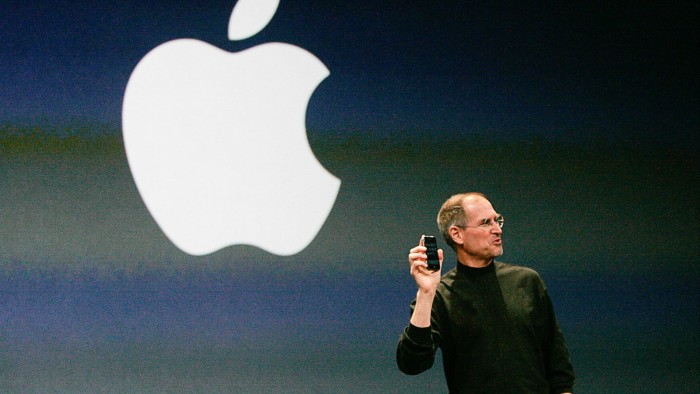Stay informed with free updates
Simply sign up to the Retail & Consumer industry myFT Digest — delivered directly to your inbox.
The writer, author of ‘Fair or Foul: the Lady Macbeth Guide to Ambition’, is a visiting professor at Bayes Business School, City St. George’s, University of London
‘It’s hard work building a brand,” declared Mary Portas, the retail consultant, to contestants on an episode of BBC television show Interior Design Masters. The “Queen of Shops” (a reference to her own TV series) knows what she is talking about. In the 1990s she helped transform the once sleepy Harvey Nichols department store into the most talked about retail destination in London.
Comparing the most valuable brands, as measured by Kantar, today and from 20 years ago, it is clear some have worked hard to stay relevant and valuable, while others have fallen away. Luck, technological innovation and management, good and bad, have all played a part in this process.
Familiar tech giants sit at the top of today’s league table, with McDonald’s (in eighth place) the highest-ranking non-tech company. Twenty years ago GE, Coca-Cola, Marlboro and Toyota all made it into the top 10. Coca-Cola — which had the tagline “happiness in a bottle” — is still highly valuable and in 14th place in 2025, but Marlboro now stands in 40th place, Toyota is down at 77th, and of GE there is no sign.
In 2005, Nokia, the Finnish telecoms group — still a giant back then — was the 14th most valuable brand in the world. Its mobile phone handsets dominated the market, and its ringtone was instantly familiar. Meanwhile, Apple was still in its wake, in 29th place. Then came the iPhone, and the situation changed. Today, Apple is the most valuable brand in the world, according to Kantar, while Nokia is nowhere to be seen in the top 100. (It remains a well-regarded tech and communications company. It is just smaller and prominent only in the business-to-business and defence markets.)
In her new book Brand Global, Adapt Local: How to Build Brand Value Across Cultures, Katherine Melchior Ray introduces the concept of a “brand fulcrum” to balance the seemingly conflicting need for a brand to respect and draw on its traditions while also innovating and keeping up with trends and shifting consumer needs.
“The fulcrum ensures a brand doesn’t become too classic and conservative, or too flirty and fleeting,” she writes. “By pushing both edges, brands can expand their range and appeal, blending heritage and craftsmanship with edgy, avant-garde innovation. This . . . creates a sense of friction that drives excitement and market relevance, ensuring that the brand evolves while staying true to its core identity. Ultimately, the brand fulcrum serves as a powerful tool for building brand relevance and value in an ever-changing marketplace.”
Melchior Ray teaches at Haas School of Business at the University of California, Berkeley, but before that was a senior executive with responsibility for brands at businesses such as Nike, Louis Vuitton, Gucci, Hyatt and Shiseido (a Japanese cosmetics business).
“A brand is a promise,” she told me in a Zoom call to discuss her work. “That logo is only a tool to communicate a promise. When you see that logo it is illustrating in your mind a whole host of intangible ideas and expectations that are created by the brand.
“And because it’s a promise, a brand has to stay true to its values. It’s born from culture . . . brands emerge from culture or cultural moments. They then need to evolve with them. And the company has to invest in it . . . and this is where it gets complicated. A brand has to be consistent, and it has to adapt.”
Brands seeking longevity have to stay in tune with the customers and communities they are hoping to serve. This is where the insights offered by anthropology can help. John Curran, a business coach (but also a PhD anthropologist and visiting professor at University College London) says brands can become “cultural artefacts” because they function as “symbols that embody shared values, identities, and social meanings within a community”.
“Brands are integrated into daily life through practices, rituals and cultural narratives,” he says. “They often symbolise aspirations, cultural ideals or social status, resonating deeply with people’s sense of belonging.”
What anthropologists call “tournaments of value” underpin conspicuous consumption and status seeking. “People can find themselves in a continuous performance of status grab — not just ‘keeping up with the Joneses’, but ‘outdoing the Joneses’,” Curran says. “This is a golden nugget for advertising and their fast-emerging AI creatives to tap into.”
Brands survive, and may flourish, when customers remain interested in them, convinced by them and value them. The most powerful become not merely brands but what Kevin Roberts, former chief executive of advertising agency Saatchi and Saatchi, called “lovemarks”.
Brands with true longevity turn out to be a bit like people: they just want and need to be loved.




